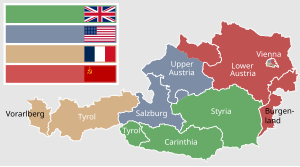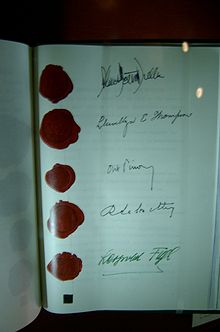This is an old revision of this page, as edited by IceWelder (talk | contribs) at 08:39, 21 November 2022 (→top). The present address (URL) is a permanent link to this revision, which may differ significantly from the current revision.
Revision as of 08:39, 21 November 2022 by IceWelder (talk | contribs) (→top)(diff) ← Previous revision | Latest revision (diff) | Newer revision → (diff) 1955 multilateral treaty regarding the international status of Austria| This article includes a list of general references, but it lacks sufficient corresponding inline citations. Please help to improve this article by introducing more precise citations. (October 2015) (Learn how and when to remove this message) |
| Type | Multilateral treaty |
|---|---|
| Signed | 15 May 1955 (1955-05-15) |
| Location | Vienna, Austria |
| Effective | 27 July 1955 (1955-07-27) |
| Original signatories | |
| Signatories |



The Austrian State Treaty (Template:Lang-de [ˈøːstəraɪçɪʃɐ ˈʃtaːtsfɛɐ̯ˌtraːk] ) or Austrian Independence Treaty re-established Austria as a sovereign state. It was signed on 15 May 1955 in Vienna, at the Schloss Belvedere among the Allied occupying powers (France, the United Kingdom, the United States, and the Soviet Union) and the Austrian government. The neighbouring Federal People's Republic of Yugoslavia acceded to the treaty subsequently. It officially came into force on 27 July 1955.
Its full title is "Treaty for the re-establishment of an independent and democratic Austria, signed in Vienna on 15 May 1955" (Template:Lang-de).
Generalities and structure
The treaty re-established a free, sovereign and democratic Austria. The basis for the treaty was the Moscow Declaration of 30 October 1943. The agreement and its annexes provided for Soviet oilfield concessions and property rights of oil refineries in Eastern Austria and the transfer of the assets of the Danube Shipping Company to the USSR.
Treaty signatories
- Allied foreign ministers:
- High commissioners of the occupying powers:
- Austrian foreign minister:
Nine parts of the treaty
- Preamble
- Political and territorial provisions
- Military and air travel provisions
- Reparations
- Ownership, Law and Interests
- Economic relations
- Rules for disputes
- Economic provisions
- Final provisions
Development
First attempts to negotiate a treaty were made by the first post-war government. However, they failed because the Allies wanted to see a peace treaty with Germany first. A treaty became less likely with the development of the Cold War. However, Austria successfully held its part of Carinthia against the demands of a resurgent Federal People's Republic of Yugoslavia, even though the issue of potential reunification with South Tyrol, annexed by Italy from Austria-Hungary in 1919, was not addressed. The climate for negotiations improved with Joseph Stalin's death in 1953, and negotiations with the Soviet foreign minister, Molotov, secured the breakthrough in February 1955.
Important points in the treaty
As well as general regulations and recognition of the Austrian state, the minority rights of the Slovene and Croat minorities were also expressly detailed. Anschluss (Austria's political union with Germany), as had happened in 1938, was forbidden (German recognition of Austria's sovereignty and independence and renunciation by Germany of territorial claims over Austria were later covered in general terms in the 1990 Treaty on the Final Settlement with Respect to Germany about existing borders, but not specifically). Nazi and fascist organisations were prohibited.
Austrian neutrality is actually not in the original text of the treaty but was declared by parliament on 26 October 1955, after the last Allied troops were to leave Austria according to the treaty.
Result
As a result of the treaty the Allies left Austrian territory on 25 October 1955. 26 October came to be celebrated as a national holiday (called the Day of the Flag until 1965). It is sometimes thought to commemorate the withdrawal of Allied troops, but in fact celebrates Austria's Declaration of Neutrality, which was passed on 26 October 1955.
See also
References
- ^ Slusser, Robert M.; Triska, Jan F. (1959). A Calendar of Soviet Treaties 1917-1957. Stanford: Stanford University Press. p. 328.
- Maier, Charles S.; Bischof, Günter; Ruggenthaler, Peter; Stourzh, Gerald; Mueller, Wolfgang (2021-11-01). "The Austrian State Treaty and the Cold War: Contending Perspectives". Journal of Cold War Studies. 23 (4): 211–245. doi:10.1162/jcws_c_01045. ISSN 1520-3972. S2CID 241566469.
- "Austrian State Treaty, 1955". 2001-2009.state.gov. 18 July 2008. Retrieved 2017-06-15.
External links
- Full Text of the Treaty
- www.staatsvertrag.at - an acoustic web exhibition on the "Austrian Independence Treaty" (in German)
- Federal Chancellor Leopold Figl exhibits the freshly signed State Treaty document to the waiting crowd (Video) (in German)
- Austria is free (in German)
- Website of the 2005 Jubilee Year
- Counter-website to the 2005 national celebrations (in German)
- Second Austrian Republic
- Allied occupation of Austria
- Anti-fascist works
- Treaties of the Soviet Union
- 1955 in Austria
- Austria–Soviet Union relations
- Treaties concluded in 1955
- Treaties entered into force in 1955
- Treaties of Austria
- Austria–United States relations
- Treaties of the United Kingdom
- Treaties of the French Fourth Republic
- Treaties of the United States
- May 1955 events in Europe
- 1950s in Vienna
- Cold War treaties